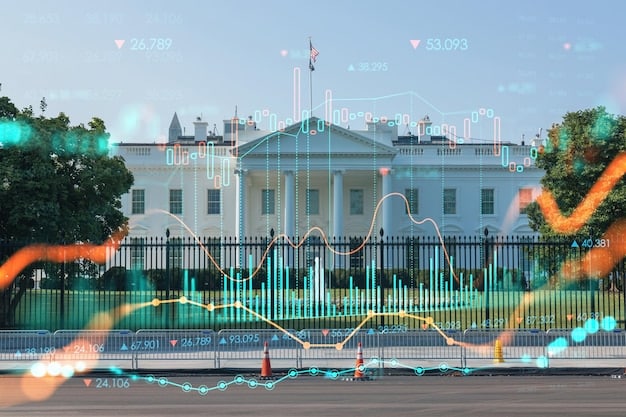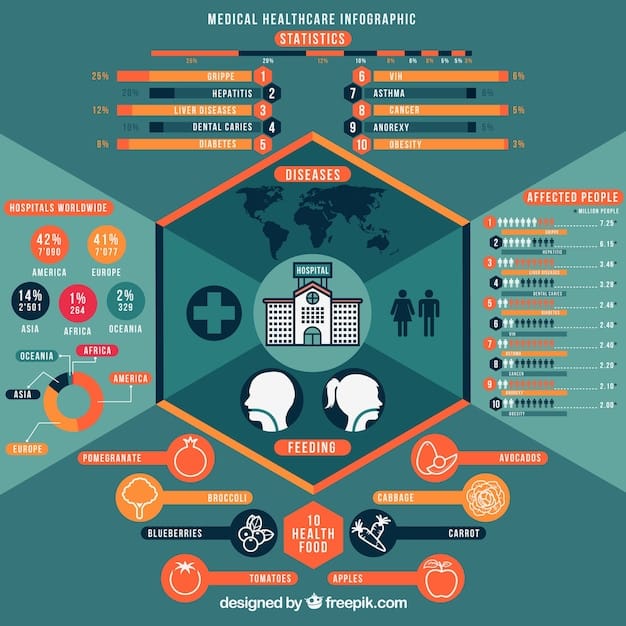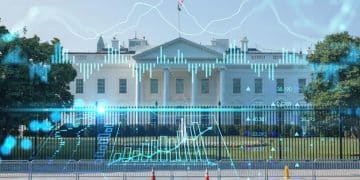Analyzing the President’s 2025 Budget: Priorities & Economic Impact

Analyzing the President’s 2025 Budget Proposal: Key Priorities and Potential Economic Effects involves examining the allocation of federal funds across various sectors, including defense, healthcare, education, and infrastructure, and assessing its probable impact on economic growth, employment, and national debt.
The Analyzing the President’s 2025 Budget Proposal: Key Priorities and Potential Economic Effects is essential for understanding the administration’s agenda and its implications for the nation’s economy. This analysis delves into the specifics of the budget, highlighting key areas of investment and potential challenges.
Overview of the President’s 2025 Budget Proposal
The President’s budget proposal serves as a roadmap for the administration’s fiscal priorities for the upcoming year. It outlines how the government intends to allocate resources across various sectors, influencing everything from national defense to social programs.
Understanding this proposal is crucial for businesses, policymakers, and citizens alike, as it can significantly impact economic conditions and future opportunities.
Key Areas of Focus
The 2025 budget proposal likely includes significant investments in several key areas. These priorities reflect the administration’s broader policy goals and strategic vision for the country.
- Infrastructure Development: Investments in roads, bridges, and public transportation aim to stimulate economic growth and improve connectivity.
- Healthcare Expansion: Initiatives to expand access to affordable healthcare and improve public health outcomes.
- Clean Energy Transition: Funding for renewable energy projects and incentives for businesses to adopt sustainable practices.
- Education and Workforce Training: Programs to enhance educational opportunities and prepare workers for the jobs of the future.

Budgetary Goals
Beyond specific investments, the budget proposal also aims to achieve certain broader economic and social goals. These objectives often include reducing the national debt, promoting income equality, and fostering sustainable economic growth.
The budget proposal is a statement of intent, signaling the administration’s commitment to addressing key challenges and opportunities facing the nation.
In conclusion, the President’s 2025 budget proposal is a comprehensive plan that sets the stage for the upcoming fiscal year. By understanding its key priorities and goals, stakeholders can better anticipate its potential impact on the economy and society.
Defense Spending and National Security
Defense spending typically constitutes a significant portion of the federal budget, reflecting the nation’s commitment to national security. The President’s 2025 budget proposal is expected to outline specific investments in military readiness, technological advancements, and international partnerships.
These allocations have profound implications for the defense industry, global security dynamics, and the overall economic landscape.
Modernization Efforts
A key focus of defense spending is often on modernizing military equipment and infrastructure. This includes investments in advanced weaponry, cybersecurity capabilities, and intelligence gathering technologies.
Modernization efforts are essential for maintaining the nation’s military advantage and addressing evolving security threats.
- Cybersecurity Enhancements: Strengthening defenses against cyberattacks and protecting critical infrastructure.
- Advanced Weaponry Systems: Developing and deploying cutting-edge weapons technologies to deter potential adversaries.
- Intelligence Gathering: Enhancing capabilities to monitor and analyze global security threats.
Impact on National Security
The proposed defense spending levels can significantly impact the nation’s ability to respond to emerging threats and safeguard its interests around the world. These decisions often involve complex trade-offs and strategic considerations.
Effective defense spending not only enhances national security but can also stimulate economic growth through research, development, and job creation.
In summary, defense spending and national security are central components of the President’s 2025 budget proposal. These allocations reflect the administration’s strategic priorities and its commitment to protecting the nation from evolving threats.
Healthcare and Social Programs
Healthcare and social programs are vital components of the federal budget, providing essential services and support to millions of Americans. The President’s 2025 budget proposal is expected to address issues such as healthcare access, affordability, and the strengthening of social safety nets.
These investments aim to improve public health outcomes, reduce poverty, and ensure a more equitable society.
Expanding Healthcare Access
A key priority is often to expand access to affordable healthcare for all Americans. This may involve strengthening the Affordable Care Act, increasing funding for community health centers, and addressing disparities in healthcare coverage.
Ensuring access to quality healthcare is not only a moral imperative but also a critical factor in promoting economic productivity and social well-being.
- Affordable Care Act Enhancements: Measures to stabilize insurance markets and lower premium costs.
- Medicaid Expansion: Extending coverage to more low-income individuals and families.
- Rural Healthcare Investments: Improving access to healthcare services in underserved rural areas.
Strengthening Social Safety Nets
The budget proposal is also likely to include measures to strengthen social safety nets, such as food assistance programs, housing assistance, and unemployment benefits. These programs provide crucial support to vulnerable populations and help mitigate the impact of economic downturns.
Investing in social safety nets can reduce poverty, improve health outcomes, and foster greater economic stability.

In conclusion, healthcare and social programs are integral to the President’s 2025 budget proposal. These investments reflect the administration’s commitment to improving public health, reducing poverty, and creating a more just and equitable society.
Impact on Economic Growth and Employment
The President’s budget proposal is expected to have a significant impact on economic growth and employment. By strategically allocating resources across various sectors, the administration aims to stimulate job creation, boost productivity, and foster long-term economic prosperity.
These policies can influence everything from small business growth to large-scale infrastructure projects.
Job Creation Initiatives
The budget proposal is likely to include targeted initiatives to promote job creation in key sectors. This may involve investments in workforce training programs, incentives for businesses to hire new employees, and support for emerging industries.
Creating new job opportunities is essential for reducing unemployment, increasing household incomes, and fostering economic stability.
- Green Jobs Training: Preparing workers for careers in renewable energy and sustainable industries.
- Small Business Support: Providing loans, grants, and technical assistance to help small businesses grow and create jobs.
- Infrastructure Projects: Constructing roads, bridges, and other infrastructure projects to create employment opportunities.
Long-Term Economic Growth
Beyond immediate job creation, the budget proposal also aims to foster long-term economic growth by investing in education, research and development, and infrastructure. These investments can improve productivity, enhance competitiveness, and drive innovation.
Sustained economic growth is essential for raising living standards, reducing poverty, and ensuring a prosperous future for all Americans.
In summary, the President’s 2025 budget proposal has the potential to significantly impact economic growth and employment. By strategically allocating resources and implementing targeted initiatives, the administration aims to create a more prosperous and inclusive economy.
Infrastructure Investments and Development
Infrastructure investments are a critical component of the President’s budget proposal, focusing on modernizing the nation’s roads, bridges, and other essential infrastructure. These investments aim to improve transportation efficiency, enhance public safety, and stimulate economic growth.
These projects create jobs, improve connectivity, and lay the foundation for future economic opportunities.
Modernizing Transportation
A key priority is often to modernize the nation’s transportation infrastructure, including roads, bridges, airports, and public transit systems. This involves repairing aging infrastructure, expanding capacity, and incorporating new technologies.
- Bridge Repairs and Replacement: Ensuring the safety and reliability of the nation’s bridges.
- Airport Improvements: Expanding airport capacity and modernizing air traffic control systems.
- Public Transit Expansion: Investing in bus and rail systems to reduce congestion and improve mobility.
Expanding Broadband Access
The budget proposal is also likely to include measures to expand broadband access to underserved areas, particularly in rural communities. This involves investing in the construction of new broadband infrastructure and providing subsidies to make internet service more affordable.
Expanding broadband access can promote economic development, improve educational opportunities, and enhance access to healthcare and other essential services.
In conclusion, infrastructure investments are a vital component of the President’s 2025 budget proposal. By modernizing transportation, expanding broadband access, and improving water systems, the administration aims to create a more resilient, efficient, and prosperous nation.
Education and Human Capital Development
Education and human capital development are essential for ensuring a skilled workforce and a competitive economy. The President’s 2025 budget proposal is expected to prioritize investments in education, from early childhood programs to higher education initiatives.
These investments aim to improve educational outcomes, reduce inequality, and prepare students for the jobs of the future.
Early Childhood Education
A key focus is often placed on expanding access to high-quality early childhood education programs, such as Head Start and universal pre-kindergarten. These programs provide young children with a strong foundation for future academic success.
- Head Start Expansion: Increasing funding for Head Start programs to serve more low-income children.
- Universal Pre-Kindergarten: Providing free pre-kindergarten to all four-year-old children.
- Teacher Training and Professional Development: Investing in training for early childhood educators.
Higher Education Affordability
The budget proposal is also likely to include measures to make higher education more affordable and accessible, such as increasing Pell Grants, reducing student loan debt, and providing tuition assistance to low-income students.
Investing in education is not only a moral imperative but also a critical factor in promoting economic growth and social mobility.
In summary, education and human capital development are central to the President’s 2025 budget proposal. By investing in early childhood education, higher education affordability, and workforce training programs, the administration aims to prepare students for success in the 21st-century economy.
| Key Area | Brief Description |
|---|---|
| 🛡️ Defense Spending | Focuses on modernizing military equipment and infrastructure. |
| 🏥 Healthcare | Aims to expand access to affordable healthcare for all citizens. |
| 🌉 Infrastructure | Modernizes roads, bridges, and expands broadband access. |
| 📚 Education | Prioritizes investments in early childhood and higher education. |
Frequently Asked Questions
▼
The main priorities include investments in infrastructure, healthcare, education, and defense, with a focus on economic growth and job creation. The budget also aims to address income inequality and promote sustainable development.
▼
The budget proposes investments in infrastructure and job training programs to stimulate economic activity and create employment opportunities. These initiatives are designed to boost productivity and foster long-term economic prosperity.
▼
The budget includes strengthening the Affordable Care Act, expanding Medicaid, and increasing funding for community health centers. These measures aim to improve healthcare access and affordability for all Americans.
▼
The budget allocates significant resources to defense spending, focusing on modernizing military equipment, enhancing cybersecurity capabilities, and improving intelligence gathering. These investments aim to protect the nation from evolving threats.
▼
The budget emphasizes early childhood education, higher education affordability, and workforce training programs. These investments aim to improve educational outcomes, reduce inequality, and prepare students for the jobs of the future.
Conclusion
In conclusion, the President’s 2025 budget proposal presents a comprehensive vision for the nation’s future, addressing key priorities such as economic growth, healthcare, education, and national security. Its potential effects will shape the economic landscape and the lives of Americans for years to come.





